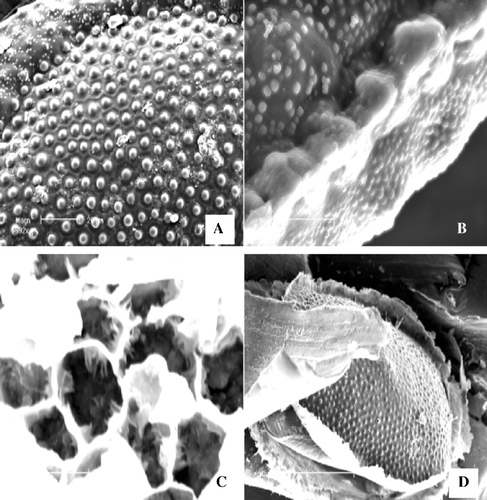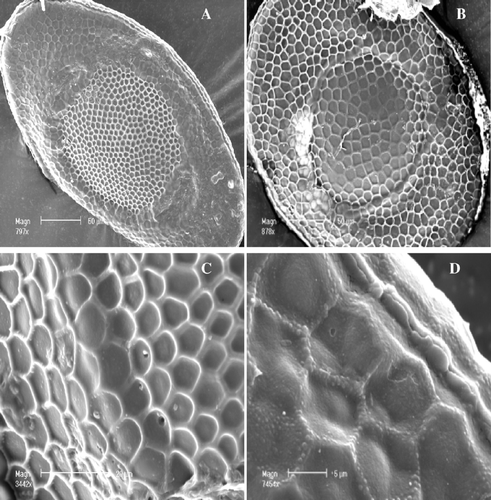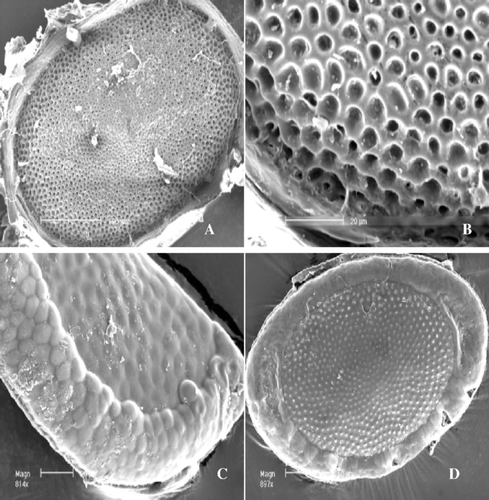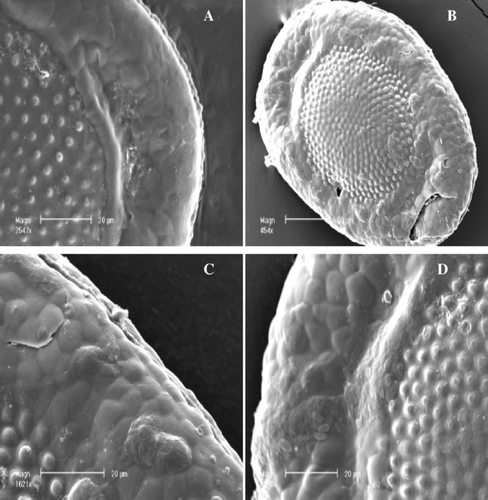Abstract
This study reports the first information on Phylactolaemata from Florida. Bryozoan floatoblasts were collected from Lake Apopka in February 2007 with a large mesh plankton net. Submerged surfaces of docks and buoys were inspected, as well as stems of Phragmites. The following bryozoan species were found: Urnatella gracilis Leidy 1851 (phylum Entoprocta) and Plumatella bushnelli Wood 2001, Plumatella vaihiriae (Hastings Citation1929), Plumatella casmiana (Oka Citation1907) and Plumatella sp. (phylum Ectoprocta, Phylactolaemata).
Until now, U. gracilis is the only species already reported in Florida: it is widely distributed in eastern North America. Due to its presence in Europe, South America, Central Africa, India and Japan, it is considered cosmopolite. P. bushnelli is known just from one site in the USA and one site in New Zealand. Few data are available for P. vaihiriae, but where this species is present it is very abundant. P. casmiana is a common and widely distributed species and can be considered cosmopolite. Future research will address the distribution and role of Bryozoa in shallow subtropical systems in Florida.
Introduction
Bryozoans in the ecosystems of shallow lakes may have great importance because they collect suspended particles of food from the water and transfer them to the bottom as faecal pellets. In this role they cooperate with zooplankton especially during the water blooms periods, and at times they may compete with the zooplankton for limiting food resources. Knowledge regarding bryozoan diversity and distribution in Florida is poor and it concerns exclusively the finding of Urnatella gracilis (Hull et al. Citation1980), whereas studies on bryozoan distribution in the northeastern USA are numerous.
Materials and methods
Sampling sites
Lake Apopka is located at 29°N 82°W in south‐central Florida, with a surface of 125 km2 and an average depth of 1.6 m. The lake is hypereutrophic with few submerged vascular plants and frequent algal blooms (Microcystis and Botryococcus), although in recent years nutrient and chlorophyll concentrations have declined and transparency has increased.
In February 2007, floatoblasts were collected from the water surface of SE near‐shore region with a rectangular net (30 meshes/cm) towed from a moving boat. Freshwater weed stems, buoys, leaves and other floating surfaces also were inspected. From the collected material the floatoblasts were picked out by means of stereomicroscopy, treated with a saturated solution of KOH for 30 s at room temperature, and washed in deionized water. Some were cut in the middle with a micro‐dissection needle using a modified method of Wiebach (Citation1964). These samples were freeze‐dried, fixed to aluminium stubs, sputter‐coated with gold‐palladium and viewed in a Philips XL 30 SEM (Taticchi & Pieroni Citation2005).
Results
With low winter temperatures, only a few colonies were found adhering to a tire hanging in the water on a boat dock; they were very young as was all of the benthic community. In the collected material were found Urnatella gracilis (Phylum Entoprocta) and three Phylactolaemata (Phylum Ectoprocta).
Entoprocta is a small group distinct in almost every way from the Ectoprocta, but historically included together under the name Bryozoa. The two groups have in common only their sessile form, ciliated tentacles and an incomplete separation of budded zooids (Wood Citation2001a).
Urnatella gracilis Leidy, 1851
Very small and young colonies were found of this species, the only known freshwater species of Entoprocta.
One or two segmented stalks arise from a basal plate. The calyx has a whorl of 14 ciliated tentacles, which surrounds both the mouth and the anus.
Plumatella bushnelli Wood, 2001
We cannot describe in detail the colony of this species because the specimen collected was very young. The tubules are colourless and transparent and contain mostly immature floatoblasts, which, on the contrary, were found to be numerous and mature in the net collected material. The elongate floatoblast has parallel or slightly incurved sides. The dorsal valve (Figure ) is most rectangular, sometimes with pointed poles (Figure ); the convex ventral valve (Figure ) always has pointed poles. Polar grooves are straight on the pointed floatoblast or C‐shaped in the rectangular form (Figure ). Both dorsal and ventral valves are covered by numerous tiny nodules, more abundant on the annular surface. On the dorsal fenestra there are equidistant and large tubercles. Ventral fenestral tubercles are similar in size to dorsal, becoming markedly dense towards the fenestra centre; they mount the annulus beyond the outer fenestral margin and blend into the annulus itself. The reticulation on dorsal and ventral fenestra is sometimes evident (Figure ) The suture (Figure ) bulges out of the annulus and it is like a cord where we can see many nodules and large not alternate tubercles that give a corrugated shape to the floatoblast margin. The annular gas chamber pores are notched as in P. repens (Figure ). The sessoblast was found only in net collected material, adhering to a leaf. It is oval in shape; the frontal valve (Figure ) is tuberculated with a pointed shape at the centre.
Figure 1 Plumatella bushnelli. A, rectangular dorsal valve. B, pointed dorsal valve. C, convex ventral valve. D, C‐shaped polar groove.

Figure 2 Plumatella bushnelli. A, fenestral reticulation. B, suture. C, annular gas chamber pores. D, sessoblast.

The floatoblasts collected in Lake Apopka generally correspond to those of North Carolina (Wood Citation2001b) and New Zealand (Wood et al. Citation1998). We can only add that the dorsal valve has a rectangular shape but sometimes it has pointed poles; the tiny nodules extend on both dorsal and ventral fenestra, where sometimes a faint reticulation can be seen.
Plumatella vaihiriae (Hasting, Citation1929)
This is the most common species collected in Lake Apopka. We found small colonies, containing statoblasts, on a tire and floatoblasts on the surface of the lake. In the same colony together with sessoblasts there are both elliptical (Figure ) and round floatoblasts (Figure ). For the first time this peculiarity has been noted. On the elliptical floatoblast the dorsal annulus at the poles is wider than half the fenestra length. On the round form the annulus is as large as the fenestra length. The dorsal valve is reticulated; the reticulum meshes (Figure ) wrap around both the annulus and the round fenestra, where, in the elliptical form, they have more evident crests. The polar groove, also reticulated, is flattened. Interstitial tubercles are completely lacking both on the annulus and fenestra. On the ventral valve the annulus is narrower than on the dorsal valve; in fact the fenestra fills three‐quarters of the ventral valve. The reticulum meshes in the central fenestra zone are smaller. The ventral valve is larger than the dorsal. At high magnification we can see small nodules on the reticulum crests. The suture is a thin cord surmounted by alternate tubercles where the reticulum meshes end (Figure ). The sessoblast (Figure ) is ornamented on the frontal lamella with holes of different size (Figure ): these on the external part result from crests of a strong reticulum; in the central part they are small holes. The elliptical floatoblasts of Lake Apopka are shaped like those collected by Wood & Marsh (Citation1999) in a fish hatchery in Williamson County, Illinois, but different from those found in a waste water treatment plant by the same author. The round floatoblasts are more like the last. Moreover, the Florida floatoblasts lack a furrow between the ventral flattened fenestra and the annulus, according to Hasting's original description; while in respect to this description they lack, as found by Wood & Marsh (Citation1999), a button‐like protuberance in the middle of the ventral fenestra. The sessoblast too is similar to those described by Wood & Marsh (Citation1999). With regard to P. vaihiriae recently found in Italy, probably imported with exotic fish and by immigrations of aquatic birds, we can say that the American species has flatter and narrower floatoblasts and on the sessoblast frontal valve the holes are denser and less deep (Taticchi et al. Citation2008).
Plumatella casmiana (Oka, Citation1907)
In the net collected material we found a half valve of a leptoblast (Figure ). This type of thin‐walled floatoblast lacks a capsule and is characteristic of this species.
Plumatella sp 1
A dorsal valve (Figure ) of an unnamed plumatellid was found. In this specimen the annulus at the poles is mostly as large as laterally. The dorsal groove (Figure ) is small and does not extend on the fenestra. It is not reticulated; the small tubercles are regular spaced and flattened in the central area.
Plumatella sp 2
It is impossible to assign the only floatoblast we found to a particular species. Here we can only describe the dorsal valve characteristics which discriminate this floatoblast from the other species of genus Plumatella. The floatoblast (Figure ) is small and oval‐round; the annulus width at the poles is twice the lateral width and one half of the fenestra length. The annulus is paved (Figure ) and lacks nodules. The dorsal groove is large and it extends across the polar region (Figure ). On the non‐reticulated fenestra there are uniform sized large tubercles.
Conclusions
This paper presents the first documentation of Phylactolaemata from Florida, USA. Previously the Entoproct Urnatella gracilis was the only known species for this State. It is present in every continent except in Antarctica and Australia. In North America the reported distribution of this species ranges from the east to the west coast and from Florida, Louisiana, and Texas to as far north as Michigan (Wood Citation2001a). Moreover, Lake Apopka is the third global site with a report of Plumatella bushnelli, following the findings in North Carolina (Wood Citation2001b) and New Zealand (Wood et al. Citation1998). Few data are available for P. vaihiriae; this species is not common and it is recorded from USA (Rogick & Brown Citation1942; Baily‐Brock & Hayward Citation1984; Wood & Marsh Citation1999); South America (Cazzaniga Citation1988); Tahiti (Hastings Citation1929); Europe (Taticchi et al. Citation2008). Plumatella casmiana was described from Japan (Oka Citation1907) and has now been reported from every continent except South America and Australia (Wood & Okamura, Citation2005). Further sampling is needed to have a more complete accounting of Bryozoa taxa in Florida lakes, and there is also a need for research to determine their role in the shallow lake ecosystems where the public and staff of water management agencies report that they periodically become abundant.
Acknowledgments
This study was in part supported by the Universities of Perugia (Italy), and of Florida (FL) ‘Cultural Framework Agreement between University of Perugia and University of Florida, 2007’ for the study of ecology of shallow lakes.
References
- Baily‐Brock , J. and Hayward , P. 1984 . A freshwater bryozoan, Hyalinella vaihiriae Hastings (1929), from Hawaiian prawn ponds. . Pacific Science , 38 : 199 – 204 .
- Cazzaniga , N. 1988 . Hyalinella vaihiriae (Ectoprocta‐Phylactolaemata) en la Provincia de San Juan (Argentina). . Revista de la Asociación de Ciencias Naturales del Litoral , 19 : 205 – 208 .
- Hastings , A. 1929 . Notes on some little‐known phylactolaematous polyzoa and description of a new species from Tahiti. . Annals and Magazine of Natural History , 10 : 300 – 310 .
- Hull , H. C. , Bartos , L. F. and Martz , R. A. 1980 . Occurrence of Urnatella gracilis Leidy in the Tampa Bypass Canal, Florida. . Florida Scientist , 43 : 2 – 13 .
- Oka , A. 1907 . Zur Kenntnis der Susswasser‐Bryozoenfauna von Japan. . Annotationes Zoologiques Japanese , 6 : 117 – 123 .
- Rogick , M. D. and Brown , C. J. D. 1942 . Studies on freshwater Bryozoa. XII. A collection from various sources. . Annals of the New York Academy of Sciences , 43 : 123 – 144 .
- Taticchi , M. I. and Pieroni , G. 2005 . “ Freshwater Bryozoa of Italy. A survey of some species from the Italian bryozoan collection of A. Viganò with new records. ” . In Bryozan studies 2004 , Edited by: Moyano , H , Cancino , J and Wyse Jackson , P. N . 317 – 327 . London : Taylor & Francis Group .
- Taticchi , M. I. , Pieroni , G. and Elia , A. C. 2008 . “ First finding of Plumatella vaihiriae (Hastings, 1929) (Bryozoa, Phylactolaemata) in Europe. ” . In Italian Journal of Zoology in press. DOI: 10.1080/11250000802016125
- Wiebach , V. F. 1964 . Untersuchunghen an sűsswasser‐bryozoen aus zentralafrika. . Muséée Royal de l'Afrique Centrale‐Tervuren, Belgique Annales‐Serie in 8°‐Sciences Zoologiquies , 129 : 1 – 42 .
- Wood , T. S. 2001a . “ Bryozoans. ” . In Ecology and Classification of North American freshwater invertebrates , Edited by: Thorp , J and Corvich , A . 505 – 525 . New York : Academic Press . 2nd ed
- Wood , T. S. 2001b . Three new species of plumatellid bryozoans (Ectoprocta: Phylactolaemata) defined by statoblast nodules. . Journal of the North American Benthological Society , 20 : 133 – 143 .
- Wood , T. S. and Marsh , T. G. 1999 . Biofouling of wastewater treatment plants by the freshwater bryozoan, Plumatella vaihiriae (Hastings, 1929). . Water Research , 33 : 609 – 614 .
- Wood , T. S. and Okamura , B. 2005 . A new key to the freshwater bryozoans of Britain, Ireland and Continental Europe, with notes on their ecology. . Freshwater Biological Association Scientific Publication , 63 : 1 – 113 .
- Wood , T. S. , Wood , L. J. , Geimer , G. and Massard , J. A. 1998 . Freshwater bryozoans of New Zealand: a preliminary survey. . New Zealand J of Marine and Freshwater Research , 32 : 639 – 648 .


